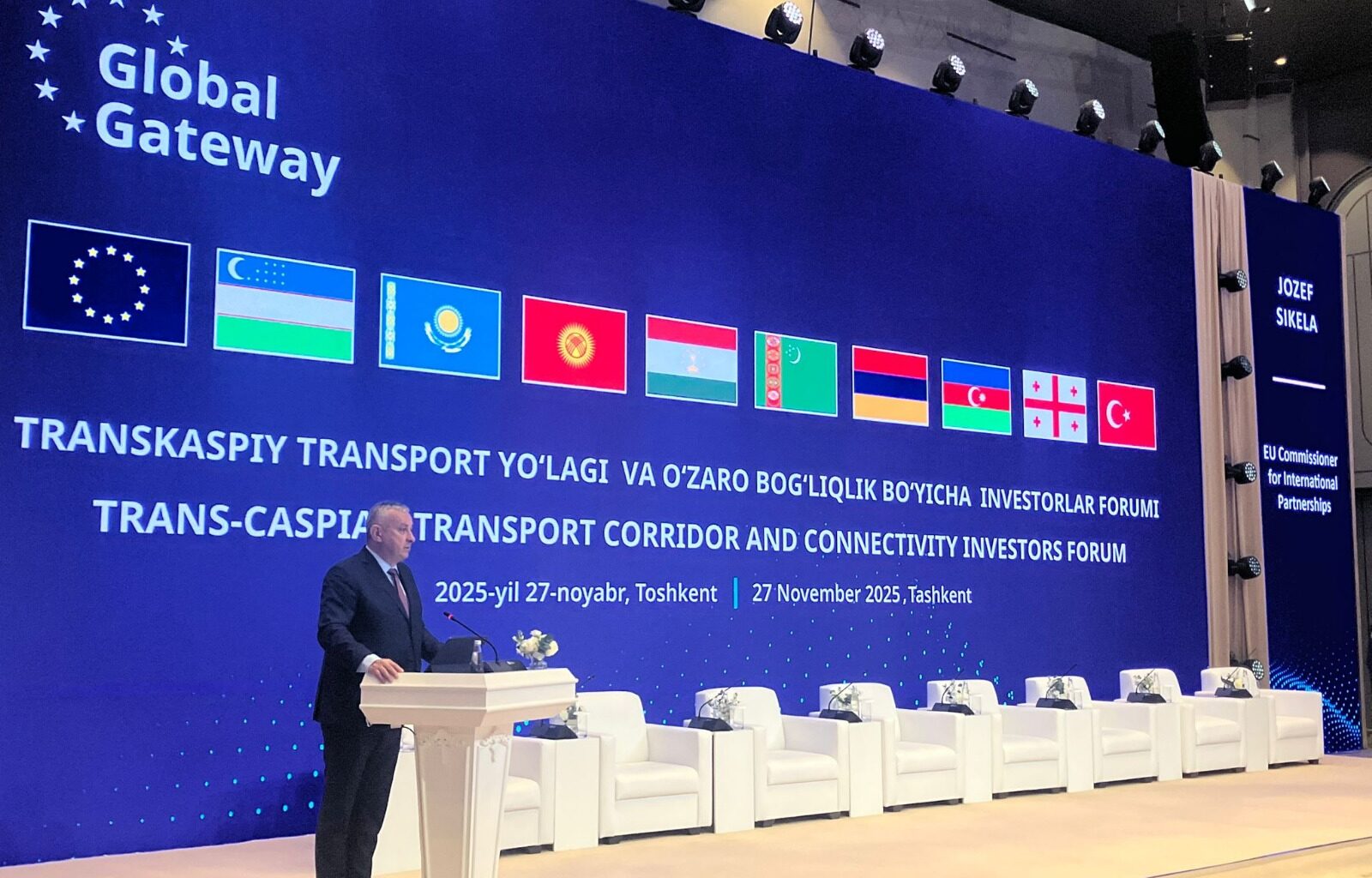TASHKENT – After years of diplomacy and billions in investments, the EU’s flagship Trans-Caspian corridor, which aims to connect Asia and Europe, remains fragmented and is increasingly dominated by Beijing.
This week’s EU-Central Asia Investment Forum, held from 26–27 November at the Intercontinental Hotel in Uzbekistan’s capital, brought together delegations from the EU and the five Central Asian states to revive enthusiasm for the Trans-Caspian International Transport Route (TITR). Enlargement Commissioner Marta Kos and International Partnerships Commissioner Jozef Síkela both attended.
Also known as the “Middle Corridor,” TITR connects China to Europe via Central Asia, the Caspian Sea, the South Caucasus, Turkey, and the Black Sea. Since Russia’s invasion of Ukraine, it has become a strategic component of the EU’s Global Gateway initiative, launched in 2022 to reduce reliance on Russian infrastructure and influence.
Brussels has poured money into the initiative, announcing €12 billion in April for connectivity projects in Central Asia, on top of a €10 billion pledge from 2024, much of which was earmarked for the Trans-Caspian route.
However, Brussels remains frustrated: despite continuous political support and rising freight volumes, the corridor’s results still fall short of expectations.
Small but strategic
On paper, the corridor strengthens Eurasian connectivity and offers an alternative to crossing Russian territory.
“It is essentially a geopolitical project,” explains Gregory Lecomte, senior policy analyst for Eurasia at the Organisation for Economic Cooperation and Development (OECD).
Since 2022, the EU has sought to reduce Moscow’s leverage over transport routes in Central Asia, a region historically shaped by Russian policy. Russia remains deeply embedded in the region’s trade networks, relying on Central Asian partners to bypass sanctions and import dual-use goods destined for its war machine.
Freight volumes through the Middle Corridor have indeed grown sharply since 2022. Traffic rose from 1.5 million tonnes that year to more than 4 million tonnes in 2024, a 64% increase. The World Bank projects flows could reach 11 million tonnes by 2030.
Yet the corridor remains marginal: it accounted for only about 3-5% of total China–Europe rail traffic in 2024, while the Russian trade route remains highly dominant.
The reasons are structural. There’s a need for multiple transshipments, infrastructure across the region has different rail gauges, and freight must cross both the Caspian and the Black Sea, all of which add delays.
Bottlenecks and lack of private capital
The biggest bottleneck is the Caspian Sea, Lecomte notes, referring to the world’s largest inland body of water that separates Central Asia from Russia and the South Caucasus. A shortage of vessels and the gradual decline in water levels have complicated port operations.
Despite ongoing upgrades at Kazakhstan’s Aktau port, congestion remains frequent. Georgia faces similar constraints: the ports of Poti and Batumi are too shallow, prompting Tbilisi to revive plans for a deep-water port in Anaklia, which a Chinese consortium will operate.
Although the Trans-Caspian route serves Europe’s geopolitical objectives, much of its infrastructure is being financed by Chinese firms.
“It would be good if European companies were a little less circumspect,” a European diplomat with knowledge of the matter told Euractiv.
Beijing has already invested nearly $25 billion (€21 billion) in Central Asia via its cross-continental Belt and Road Initiative, much of it linked to the Trans-Caspian route.
But attracting private European capital remains difficult. According to a recent OECD study surveying over 150 firms, the private sector sees strong potential in the TITR but highlights serious constraints: corruption, high costs, and regulatory instability.
Added to this are significant geopolitical uncertainties.
“There is uncertainty about how long the war in Ukraine will last,” said a representative of a consulting firm in Tashkent, who asked to remain anonymous.
“What will be the point of this route if relations between Russia and Europe normalize again? Going through Russian territory is currently much cheaper and faster,” the source added.
For now, TITR infrastructure is financed almost exclusively by public budgets and international financial institutions such as the European Bank for Reconstruction and Development (EBRD) (€1.5 billion in projects) and the European Investment Bank (EIB) (€1.47 billion committed).
Central Asia is looking to the South
Even for governments in the region, the Caspian route holds limited appeal.
“Central Asian countries are turning more towards the south. A truck leaving Termez, in southern Uzbekistan, takes only 19 hours to reach a Pakistani port,” explained a European diplomat.
Moreover, mandatory transshipments, the requirement to use local drivers, and informal payments at borders also hinder trade, reflecting competition between states rather than regional cooperation.
In Tashkent, however, enthusiasm appeared genuine among both European and Central Asian participants.
Whether those commitments will be enough to overcome the logistical and political barriers that still hinder the Trans-Caspian corridor remains uncertain.
For Brussels, TITR remains both a strategic necessity and a test: can the EU offer a credible alternative to Russian routes, or will Europe’s flagship corridor remain a corridor of good intentions?
(cs, cm)
